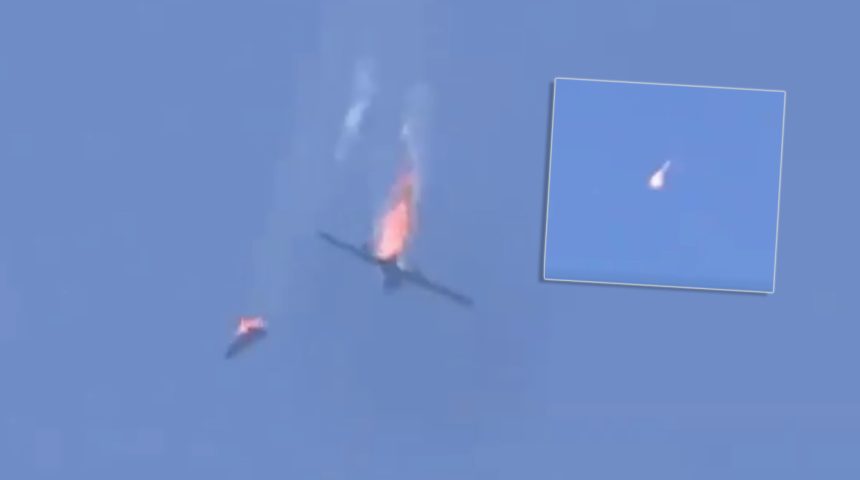The Turkish Air Force shot down two Syrian Su-24 Fencers today. A Turkish Anka-S drone drone was also downed.
On Mar. 1, 2020, two Syrian Arab Air Force Su-24 jets and a Turkish Anka-S drone were reportedly shot down over the Idlib region, in northwest Syria, where tensions have escalated after 33 Turkish soldiers were killed in an air strike by Damascus prompting Ankara to ramp up its attack against the Syrian army as part of its cross-border military operation dubbed “Spring Shield”.
“[…] Two Su-24 regime jets were downed after attacking our jets,” the Turkish Ministry of Defense said in a written statement.
BREAKING — Turkey downed two Syrian SU-24 jets which tried to attack Turkish planes and destroyed one air defense system that shot down a Turkish drone — Turkish Defense Ministry
— Ragıp Soylu (@ragipsoylu) March 1, 2020
The jets were shot down as they attempted to attack Turkish planes, the Turkish ministry said, without giving further details, although several sources suggest that the two Syrian Fencers were shot down by Turkish Air Force F-16s. Interestingly, Ankara also bombed the Syrian air defense systems that downed one Turkish armed droned in Idlib. According to the Syrian Arab News Agency the aircrews of the Syrian jets ejected with parachutes and landed safely.
Video supposed to show one of the Su-24 downings have started ciculating on social media:
В настоящее время касательно инцидента поступают противоречивые отчеты:
Оппозиционные источники сообщают, что истребитель F-16 ВВС Турции сбил бомбардировщик Су-24 ВВС САР/ВКС РФ. pic.twitter.com/RY7iVovAgT
— SwankyStas (@StasSwanky) March 1, 2020
The Su-24 Fencer is a swing-wing attack plane operated by both the Syrian Arab Air Force (and by the Russian Air Force that has deployed the type in Syria for the first time in 2015). The Su-24 Fencer is a supersonic, all-weather attack aircraft developed in the Soviet Union and serving, among the others, even with the Iranian and Libyan Air Force. It’sa twin-engined two-seater plane with a variable geometry wing, designed to perform ultra low level strike missions.
Türkish Army downed two #Esed Jet SU 24 in #Idlib! @nyt10 @washingtonpost pic.twitter.com/Y1287B9JAh
— Mehmetcik (@Mehmetc06762653) March 1, 2020
On Nov. 24, 2015, a Russian Air Force Su-24M belonging to the contingent deployed to western Syria, was shot down by a Turkish Air Force F-16 after violating Ankara’s airspace in the Hatay region. Here you can find all the details about the downing and subsequent CSAR (Combat SAR) mission launched by Russian choppers, one of those was destroyed by rebels on the ground, where the helicopter had performed an emergency landing. According to the Turkish authorities, the Russian plane was warned 10 times in 5 minutes while it approached the boundary with another Su-24, before it was engaged.
The violation was extremely short: flying at 19,000 feet, the Fencer crossed the Turkish airspace for 17 seconds. While one of the Fencers egressed towards the Syrian airspace, the doomed Su-24 was hit by an air-to-air missile (AIM-9X, based on the Russian report that mentions an IR-guided weapon; other sources suggested it may have been an AIM-120).
We still don’t know much about the downing on Mar. 1, 2020. Actually, there are unconfirmed reports of a third Su-24s shot down over Syria today. Let’s see if additional details will emerge in the next hours.
Deux avions de combat appartenant au régime franchissant la frontière ont été abattus par des F-16 turcs. Il est devenu clair que l’un des avions était le #Su-24. pic.twitter.com/8tBuVqX7th
— Clash Report (@clashreport) March 1, 2020
Anyway, few hours before the downing of the Syrian Su-24s, footage started to appear on Twitter of the Turkish drone shot down by the Syrian Air Defense. Initially believed to be a fighter jet, it was later clearly identified as a Turkish Anka-S drone.
#UPDATE: Closer images appear to show aircraft shot down over Saraqib, Idlib, may actually be a large drone pic.twitter.com/XMMaqVz75s
— ELINT News (@ELINTNews) March 1, 2020
The Anka-S is a Turkish Medium Altitude Long Endurance (MALE) UAV in an intelligence, surveillance and reconnaissance (ISR) platform whose development began in 2004. Equipped with ViaSat’s VR-18C Highpower SATCOM antenna and a national flight control computer, the Anka can fly up to 24 hours and carry up to 200 kg in payload. The first weapon integrated in the Anka is the Roketsan’s MAM-L smart micro munition, a glide-bomb derivative of the laser-guided long-range anti-tank missile system (L-UMTAS) with a semi-active laser-homing (SALH) seeker that can be used to engage stationary and moving targets. Another Anka-S was shot down in Syria on Feb. 25, 2020.
dropped drone-Tr Anka pic.twitter.com/8q1kiAQ0pi
— Y.N.M.S (@ynms79797979) March 1, 2020
It seems over Idlib was downed another Turkish ANKA-S pic.twitter.com/Y13KyVqWrb
— Yuri Lyamin (@imp_navigator) March 1, 2020









